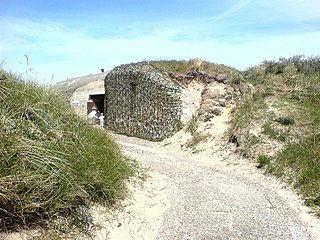 W
WHohlgangsanlage are a number of tunnels constructed in Jersey by occupying German forces during the occupation of Jersey. The Germans intended these bunkers to protect troops and equipment from aerial bombing and to act as fortifications in their own right.
 W
WJonastal, situated in the Ilm-Kreis district in Germany between Crawinkel and Arnstadt and near to the town of Ohrdruf, was a scene of military construction under the National Socialist regime during the last years of the Second World War. Thousands of prisoners from the Buchenwald concentration camp under the command of SS General Hans Kammler were forced to dig 25 tunnels into the surrounding mountain and the whole operation was performed under the strictest secrecy. The site was not completed and construction was abandoned before the end of the war.
 W
WThe Nazi gold train or Wałbrzych gold train is an urban legend about a train laden with gold and treasure that was hidden by the Nazis in southwest Poland during the last days of World War II. The apocryphal tale claims the train full of valuables, including artwork, was concealed in a sealed-up rail tunnel or mine in the Central Sudetes by retreating Nazis. Despite numerous searches being made since 1945, including ones by the Polish Army during the Cold War, no evidence of the train, its tracks or treasure have ever been found. Historians believe the train never existed.
 W
WRiese is the code name for a construction project of Nazi Germany in 1943–1945, consisting of seven underground structures located in the Owl Mountains and Książ Castle in Lower Silesia, which was in Germany but is now in Poland.
 W
WThe Seegrotte, near Hinterbrühl, Austria, is a cave system with a large grotto located under a former gypsum mine.
 W
WSkagen Bunker Museum is a private museum near the tip of Grenen in the far north of Jutland, Denmark. It is located in an old German bunker of the Regelbau 638 type which was used during the Second World War as an infirmary for treating wounded soldiers. It is now fitted out as a small museum with uniforms, weapons and other artifacts.
 W
WThe Vorbunker was an underground concrete structure originally intended to be a temporary air-raid shelter for Adolf Hitler and his guards and servants. It was located behind the large reception hall that was added onto the old Reich Chancellery, in Berlin, Germany, in 1936. The bunker was officially called the "Reich Chancellery Air-Raid Shelter" until 1943, when the complex was expanded with the addition of the Führerbunker, located one level below. On 16 January 1945, Hitler moved into the Führerbunker. He was joined by his senior staff, including Martin Bormann. Later, Eva Braun and Joseph Goebbels moved into the Führerbunker while Magda Goebbels and their six children took residence in the upper Vorbunker. The Goebbels family lived in the Vorbunker until their deaths on 1 May 1945.
 W
WIn 1944 the Third Reich began work on the construction of a partially underground bunker factory codenamed Weingut I in the forest known as the Mühldorfer Hart, slightly to the west of Mühldorf am Inn in Upper Bavaria. Plans for the bunker called for a massive reinforced concrete barrel vault composed of 12 arch sections under which Messerschmitt Me 262 jet engines would be manufactured in a nine-storey factory.